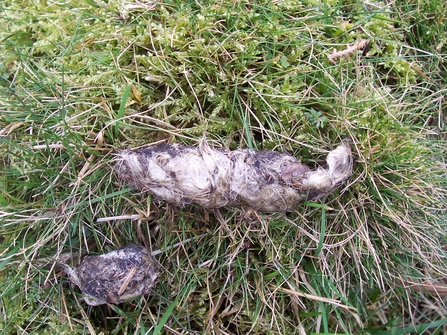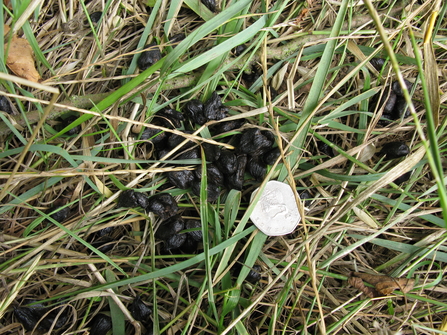Poo #1

Badger droppings in latrine ©Montgomeryshire Wildlife Trust
Clue
These woodland animals eat just about anything, so their droppings can be all sorts of shapes and sizes. A squidgy splat shows they've been wolfing down worms and a purple pile packed with seeds means it was berries for breakfast! They poo in shallow pits called latrines which they dig near their underground homes.
Answer

Andrew Mason
Badger!
Poo #2
Hedgehog droppings ©Darren Tansley
Clue
You might spot this prickly creature's poo on your patio or lawn. The black droppings are about the size of your little finger and sparkle like jewels! This is because they're full of bits of the insects this animal loves to eat.
Answer

© Jon Hawkins - Surrey Hills Photography
Hedgehog!
Poo #3
Otter spraint ©Darren Tansley
Clue
The poo of this slippery customer is called 'spraint'. It's dark and sticky when it's fresh and contains the scales and bones of fish and frogs. Spraint is often left in obvious places on riverbanks and under bridges. Some people think it smells sweet or like a summer hay meadow!
Answer
Otter!
Poo #4

Fox scat ©Sue Crookes
Clue
If you find the poos of these cunning carnivores, don't sniff 'em - they stink! These droppings are known as 'scat' and are black, twisted and pointed at one end. You can often see fur or feathers inside the faeces from the animals and birds that these predators hunt and scavenge.
Answer

Danny Green
Fox!
Poo #5

Deer droppings ©Darren Tansley
Clue
These large herbivores do their business about thirteen times a day, each time producing around 75 pellets of poo - that's nearly 1000 plops per day! If they've been eating lots of fresh grass and fallen fruit, then these grape-sized droppings stick together in a black blob called a 'crottie'.
Answer
©Gillian Day
Deer!
Poo #6

Bat droppings ©Montgomeryshire Wildlife Trust
Clue
The droppings of our only flying mammals are frequently found underneath their favourite feeding and sleeping spots. These tiny number twos are dry and crumbly and look like grains of black rice. They're made up of the remains of moths, midges and other insects and don't smell much at all!
Answer

Lesser horseshoe bat ©Shutterstock
Bat!
Poo #7

Water vole droppings © Darren Tansley
Clue
The droppings of these furry rodents look like little green 'tic tacs'. Piles of them are found on the banks of rivers and streams where they've been nibbling the stems of grass and reeds.
Answer

©Margaret Holland
Water vole!

Otter sprainting ©Margaret Holland
How did you do?
0 - Pooless
1-3 - Dung detective
4-6 - Scat-tacular!
7 - Poofect!
Did you know?
Many mammals use their droppings in much the same way that humans use social media! Foxes, otters, badgers, pine martens, water voles and rabbits all poo on purpose in prominent places such as the tops of rocks, grassy mounds and tree stumps.
The scent of their scat acts like a 'status update', telling other members of their species important information about the animal that produced it - like its age, if it's male or female and whether it's looking for a mate.

